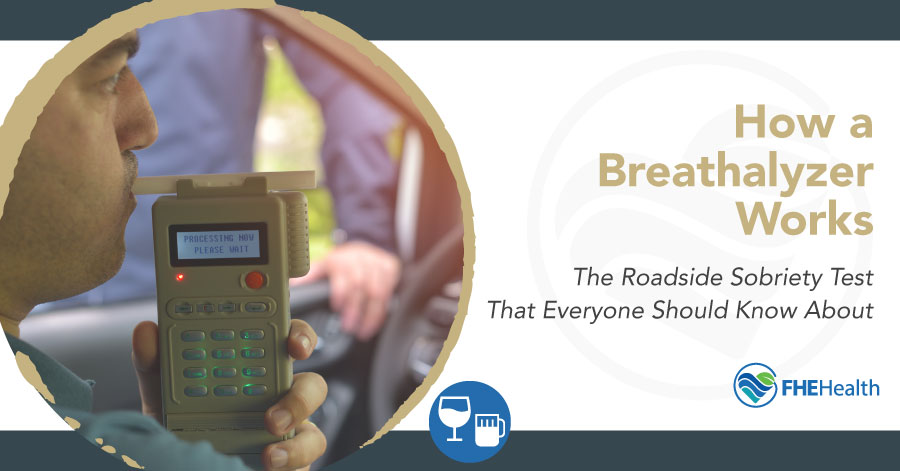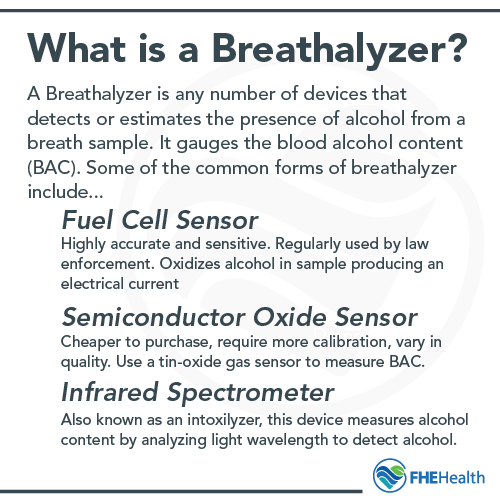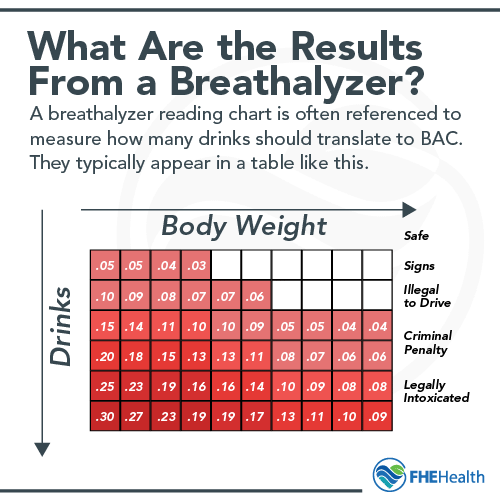
Updated January 4th, 2022
According to the National Highway Traffic Safety Administration, one person dies in a drunk driving accident about every 39 minutes in the U.S. While we all know that being over the legal alcohol limit and getting behind the wheel of a car is risky, unfortunately it still happens. Even if a person feels fine to drive, they may be intoxicated in the eyes of the law.
If you are ever pulled over by a police officer and have been drinking, here is everything you need to know about what to expect, as well as key information about breathalyzer and field sobriety tests.
What Is a Breathalyzer?
A breathalyzer is a device that estimates the presence of alcohol in the body. It determines the blood alcohol content (BAC), or concentration of alcohol present, with the goal of determining if someone is above the legal limit. There are several types of devices used for this process, including a fuel cell sensor, a semiconductor oxide sensor, and an infrared spectrometer. Each works using a different process to provide the same results.
How Does a Breathalyzer Work to Determine Intoxication?
 BAC is an easier way to determine intoxication than conducting a true blood test. Urine tests, which can also be helpful in determining intoxication levels, are also not ideal for police officers to use. The first BAC devices, developed in 1954, were designed to test for alcohol’s presence using just a person’s breath. It’s an easy way for a police officer to determine, along with other tools, if a person’s ability to drive is impaired.
BAC is an easier way to determine intoxication than conducting a true blood test. Urine tests, which can also be helpful in determining intoxication levels, are also not ideal for police officers to use. The first BAC devices, developed in 1954, were designed to test for alcohol’s presence using just a person’s breath. It’s an easy way for a police officer to determine, along with other tools, if a person’s ability to drive is impaired.
These devices work because the body does not absorb alcohol through normal digestion. Alcohol also does not change chemically in the bloodstream. Rather, the alcohol within the blood is able to move to the lungs. As a result, it can move across the alveoli, which are small air sacs in the lungs. Alcohol evaporates into the air within these sacs.
When a breathalyzer is used, the air coming from the lungs — and these air sacs — contains the concentration of alcohol expected in the bloodstream. The device can pick up this presence easily, giving the police officer clear information about just how much alcohol is moving through the bloodstream.
When May You Have to Have a Breathalyzer?
States have very specific laws regarding alcohol consumption and driving. It’s understood that too high an alcohol concentration in the blood means a person isn’t able to react fast enough or manage the process of driving, putting themselves and others at risk. If a police officer spots a person driving erratically, they may have the legal right to pull that individual over.
State laws differ on when a police officer can pull over a person for suspicion of driving under the influence. If pulled over, the individual may be subject to a breathalyzer, again depending on the laws of the state. A BAC of 0.8% is the legal limit in the United States for noncommercial drivers. Anything beyond this can result in a citation.
A breathalyzer can also be used if you’ve already been convicted of driving under the influence. Some states require individuals with a charge like this on their record to install a breathalyzer device in their vehicle. It attaches to the controls and restricts your ability to start the car until you breathe into the device. If your BAC is above the legal limit, the car will not allow you to start it.
What Is a Breathalyzer Reading Chart?
 A blood alcohol level chart can provide you with information on how high your BAC is likely to be based on how many drinks you’ve had. This type of chart is in no way guaranteed to be accurate. However, such a chart can give you some insight into when it is no longer safe to get behind the wheel.
A blood alcohol level chart can provide you with information on how high your BAC is likely to be based on how many drinks you’ve had. This type of chart is in no way guaranteed to be accurate. However, such a chart can give you some insight into when it is no longer safe to get behind the wheel.
It works by calculating your likely BAC level based on your weight, as well as the number of drinks you’ve had. The more drinks, the higher your BAC is. A person who weighs less requires fewer drinks to reach these unsafe levels.
A Key Warning About Blood Alcohol Level Chart Time
Keep in mind that the amount of time elapsed, the rate of drinking and the rate of a person’s metabolism all play a role in how many drinks it takes to reach intoxication. For someone who is drinking one beer every two hours, reaching an illegal limit may not occur for some time. However, if a person has a faster rate of metabolism, this will change the accuracy of the chart itself.
What Is a Field Sobriety Test?
A field sobriety test is a set of tests that officers use to help them determine if a person has been driving while impaired. Alcohol is usually suspected, but a person could be ill or affected by the medications they’re taking. These tests evaluate a person’s coordination, balance and ability to focus. The tests are admissible in court and are associated with a 90 percent accuracy rate when conducted by an experienced police officer.
Typically, officers don’t rely on one test over another. Usually, they will conduct the field sobriety tests first. If the individual fails these tests, the officers will request they take a breathalyzer test. Of course, it is possible to fail the sobriety test but pass the breathalyzer, because alcohol is not the only explanation for failing a sobriety test. A person might be sleep deprived or ill, for example. That’s why police prefer to have the breathalyzer readings to confirm that a person has, indeed, surpassed the legally allowed limit of blood alcohol.
What Are Some Examples of Roadside Tests?
The first test that officers will usually conduct to determine sobriety is the “horizontal gaze nystagmus” test. When a person’s eyes rotate at different peripheral angles, their eyeballs will jerk voluntarily. However, when a person is under the influence this jerking tends to become more pronounced.
To conduct this test, the officer will ask the individual to follow a moving object with their eyes. They might use a flashlight or their pen, moving it side to side. The officer will be looking for clues. For instance, they want to note if the angle of the jerking begins within 45 degrees or if the eye cannot follow the pen or flashlight smoothly. If a person fails this test, the officer will likely request the driver to provide breathalyzer readings. This test has been determined to be accurate in nearly 80 percent of cases.
The next field sobriety test that officers will administer is the “walk and turn” test, which helps them to measure the driver’s coordination abilities. The officer will request the driver to walk nine steps in a straight line with heel-to-toe precision. After the ninth step, they must turn on one foot and take the nine steps back to their starting point. The officer will be looking for a number of indicators to determine if the individual is impaired. These indicators include:
- Does not walk heel-to-toe
- Begins the test before the officer completes the instructions or tells them to begin
- Is unable to maintain balance while standing still
- Loses balance during the walk or during the turn
- Pauses at any point to regain their balance
- Relies on their arms to help them maintain balance
- Takes the wrong number of steps
If a driver ‘fails’ to pass this test, they’ll be asked to provide breathalyzer levels. According to NHTSA, this balance test is accurate 68 percent of the time and shows that the individual’s BAC is likely to be .10 or higher.
Finally, officers will administer the “one leg” test to determine if the individual can maintain balance. They’ll instruct the driver to stand with one foot suspended six inches above the ground while and count until the officer instructs them to put their foot back on the ground. As the person counts (one thousand one, one thousand two, etc…), the officer will look for these indicators to determine if the individual may be over the legal alcohol limit:
- Putting their foot down before instructed to
- Hopping on their foot to maintain balance
- Swaying while attempting to balance
- Using their arms to maintain balance
Breathalyzers for Marijuana
According to recent reports, police officers may now have access to a breathalyzer designed to detect marijuana. A pot breathalyzer can be a tool that helps police officers determine if a person is impaired when operating a vehicle. Though state laws continue to change in terms of illegal use of pot, anyone who is using and is impaired, or considered unable to drive a vehicle safely, can face a citation.
Though these may not be found in the field as readily as alcohol breathalyzers, they are in development and may prove a valuable tool for minimizing driving while impaired. A pot breathalyzer could provide police officers with valuable evidence in fighting this type of high-risk crime.
What Are the Consequences of Failing a Breathalyzer Test?
Each state sets its rules on the consequences of a failed breathalyzer. In some situations, individuals may face serious consequences. This may include a loss of driving privilege and fines. In some cases, individuals may be required to enroll in substance abuse programs or have a breathalyzer installed in their vehicle. Jail time is possible in other cases, especially in a situation where an individual has had failed breathalyzer results numerous times.
Can You or Your Beer Buddy Beat a Breathalyzer Test?
A police officer has pulled you or your beer buddy over under suspicion of a DUI and your first instinct may be to try to beat a breathalyzer. Is it possible? The answer depends on who you ask and, in some cases, where you live.
Some say yes. It is possible to beat a breathalyzer with “one simple trick” that we’ll touch on shortly. Even so, it’s probably not a reliable solution if you need to get out of a potential legal problem.
Another way to beat a breathalyzer test is to have the results thrown out in court. This is also unreliable because it depends on several circumstances that are out of your control.
What you shouldn’t do is refuse to take the test (or any other tests) offered at a DUI checkpoint or traffic stop under suspicion of DUI. Many states, including Florida, specify that if you refuse any sobriety tests, your driving privileges will be suspended for at least a year — regardless of the outcome of your case.
Here are the things you need to know about beating a breath test:
How to “Trick” a Breathalyzer
Across the internet, there’s a multitude of claims that certain tricks will beat a breathalyzer test. Most of these are questionable. There are a few that aren’t backed up by trustworthy sources but often appear in search results and are part of these discussions:
- Holding your breath before testing
- Hyperventilating (breathing abnormally fast) before testing
The logic behind both is the same: modern breathalyzers are programmed to detect when your breath is coming from the deeper regions of the lungs because that’s where the most accurate readings will reside. By using one of these two tactics to try to avoid accessing this air, you may be able to get through the test using shallow breathing.
Again, the evidence behind these methods is purely anecdotal, and you may make the situation worse if the officer notices you are using these tactics.
Accuracy Concerns with Breathalyzers
There are serious questions about the accuracy of breath tests when using standard-issue portable breathalyzers during a DUI stop. Here are a few reasons why.
First, they have been accused of ignoring physiological differences in the individuals taking the tests. Because they test air from the lungs, they don’t account for factors like sex, height, weight or metabolism. This can cause results to overestimate or underestimate a person’s actual BAC.
Second, they’re less accurate than other methods of testing. One study found that results (compared to more accurate blood tests) only fell within .01 of the actual BAC 33% of the time in a sample of 404 cases.
Are All Breath Tests Admissible in Court?
In some states, roadside breath test results are considered inadmissible in court. They may be cited as probable cause for the traffic stop, but they cannot lead to a verdict in a DUI case. This isn’t true in all states. It may come down to a judge’s ruling on the other facts surrounding the stop.
This is why when you’re arrested for DUI, you’ll have to take either a blood test or a more accurate breath test at the station during processing.
The PBT vs. the EBT
In many states, breathalyzer results are classified in two separate ways depending on how they may be used in the case. The Preliminary Breath Test (PBT) is done at the roadside or wherever your vehicle is stopped. This test is done with a portable breathalyzer device that police are trained to carry with them and use whenever they suspect a driver is under the influence of drugs or alcohol.
The Evidentiary Breath Test (EBT) is the one that’s used in court to prove that an individual was under the influence when they were arrested. This breath test is usually administered at the police station and has a very sensitive computer inside it that can get a reliably precise reading of your BAC. The industry standard — and preference in many police precincts — for detecting blood-alcohol is a blood test.
Using a Breathalyzer’s Accuracy Flaws to “Win” in Court
Whenever someone hears that breathalyzer data isn’t the most accurate, their first question is obvious. Does that mean you can use these concerns to win in court and beat your case?
The answer is yes and no. It depends on a few factors:
- The state you’re located in: Some states have a much higher standard for proof in a DUI case than others. If the only breath test you were offered was a roadside (PBT) breathalyzer screening, the court may decide that there’s not enough evidence to move forward with a conviction.
- The judge in your case: Some judges trust different types of evidence more than others. Some may require the most accurate evidence of BAC available, in which case, a portable breath test might not meet the standard.
- The arresting officer: Larger police departments have officers, who are specially trained to provide sobriety tests, and they’ll call them in when they pull someone over on suspected DUI, especially if it’s at a specific sobriety checkpoint. These officers are credible, so if one testifies against you, the inaccuracy of the breathalyzer results may not be sufficient evidence to discount the charges.
In any of these cases, you may have a chance to beat a DUI charge. However, if you find yourself wondering if it’s possible to trick or beat a breathalyzer, you may be overlooking something. If you think you might fail a breath test, it means you made the choice to get behind the wheel after having too much to drink. Do you and your beer buddy regularly find yourselves in situations where you face so-called “beer pressure,” which is when someone is pressured to drink by friends? Or maybe you’re both just comfortable in a culture that says “real men drink beer.” If so, it could be time to ask yourselves, “Do I actually have a drinking problem? Is it time for me to get help?”
A DUI is often a sign that your drinking habits have gotten out of your control. At FHE Health, we offer a range of treatment options to help people take control of their relationships with alcohol and other substances and get the support they need.
Have You Failed a Breathalyzer? FHE Health Can Help.
If you’ve failed a breathalyzer test and are headed to court, consider the benefits of enrolling in an alcohol treatment program. Doing so may help the courts to see that you are taking steps to voluntarily handle the problem, which can help you to potentially minimize the consequences of impaired driving. There is no guarantee of this, but many people need help to end substance abuse.
If you are facing the consequences of a failed DUI, take action now by calling FHE Health. Call us today to learn more about the substance abuse treatment options available to you. Our compassionate counselors are available 24/7 to offer help and guidance to you for any type of alcohol-related addiction.






